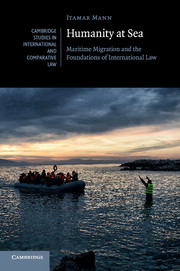Book contents
- Frontmatter
- Dedication
- Epigraph
- Contents
- List of Figures
- Acknowledgments
- Introduction: Humanity Washed Ashore
- 1 Flagless Vessel
- 2 What Is a Human Rights Claim?
- 3 What Is a Human Rights Commitment?
- 4 Between Moral Blackmail and Moral Risk
- 5 The Place Where We Stand
- 6 Imagination and the Human Rights Encounter
- Conclusion: The Dual Foundation of International Law
- Postscript
- Index
- CAMBRIDGE STUDIES IN INTERNATIONAL AND COMPARATIVE LAW
4 - Between Moral Blackmail and Moral Risk
Published online by Cambridge University Press: 05 September 2016
- Frontmatter
- Dedication
- Epigraph
- Contents
- List of Figures
- Acknowledgments
- Introduction: Humanity Washed Ashore
- 1 Flagless Vessel
- 2 What Is a Human Rights Claim?
- 3 What Is a Human Rights Commitment?
- 4 Between Moral Blackmail and Moral Risk
- 5 The Place Where We Stand
- 6 Imagination and the Human Rights Encounter
- Conclusion: The Dual Foundation of International Law
- Postscript
- Index
- CAMBRIDGE STUDIES IN INTERNATIONAL AND COMPARATIVE LAW
Summary
On Saturday, October 6, 2001, the Adelaide cruised the Indian Ocean – part of an Australian Navy operation aimed to prevent unauthorized migrants from accessing the country's territory. In the previous month or so, unauthorized migrants had kept the forces busy, several boatloads of people making attempts to enter Australia. It was presumably not a surprise when Commander Norman Banks received a signal alerting him that yet another boat was on its way. A patrol aircraft first detected the migrants shortly after 1 pm, 100 nautical miles north of Australia's Christmas Island. From his position in the sky, the pilot could see that the migrants had their brightly colored life jackets buckled on.
Half an hour later, Banks and the Adelaide edged closer to the migrant boat. Following their operational guidelines, they didn't approach it and stopped nine or ten nautical miles away. This brought the Navy vessel “just beyond the horizon,” as a parliamentary report on “A Certain Maritime Incident” would later put it. They were as close as possible, without becoming visible from the migrants' perspective. While the migrants couldn't see the Australian ship, this blindness was not mutual. Surveillance equipment allowed the navy to see while not being seen.
Lurking beyond the curve of the planet in the afternoon sun, the image of the Adelaide might recall a predator waiting for its prey. But Banks and his crew did not intend any kind of ambush. As the Commander later explained, he intended to prevent the migrants from thrusting their bodies into the water in sight of the Australian ship. Under the law of the sea, this would force the Australians to initiate rescue, creating subsequent legal obligations toward the rescued party. Such obligations were precisely what the guidelines from Canberra were designed to avoid: “moral blackmail” was what they called it.
This stealthy positioning of the Adelaide with respect to the migrant boat is emblematic of an important moment in the history of human rights. It informs much of the policy debate in response to the contemporary refugee crisis. This chapter and the next explore what such practices of intervention in the staging of encounter might mean for human rights, as characterized so far.
- Type
- Chapter
- Information
- Humanity at SeaMaritime Migration and the Foundations of International Law, pp. 134 - 162Publisher: Cambridge University PressPrint publication year: 2016

